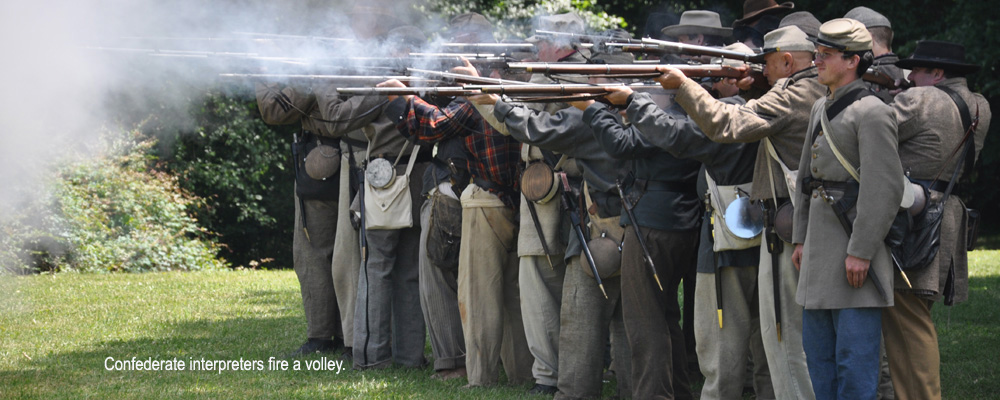Smoke drifts from a campfire, mingling with the smells emanating from a black kettle suspended above it. A group of children of diverse ages draws 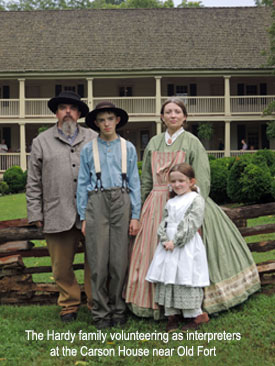 near to what appears to be a vision from the past—someone dressed as a Civil War soldier or maybe an eighteenth century longhunter. “Are you going to eat that?” one young scholar inquires. “Did you really sleep out here last night?” “Is that gun real?” The questions often come as quickly as they can be answered, and one answer can generate another host of questions. At a meticulously conserved historic home, a docent in period dress guides a group on a tour into the daily life of another century, patiently explaining details ranging from profound questions about infant mortality to more prosaic concerns about bathing practices. On a decommissioned military vessel, a volunteer depicting a sailor from a bygone era guides visitors through the operations of weapons once used by the greatest generation. On any given weekend, students across the state have a chance to understand and experience a variety of time periods by interacting with historical interpreters and volunteers at our many historical museums and sites. For homeschoolers, these sites are tremendous resources.
near to what appears to be a vision from the past—someone dressed as a Civil War soldier or maybe an eighteenth century longhunter. “Are you going to eat that?” one young scholar inquires. “Did you really sleep out here last night?” “Is that gun real?” The questions often come as quickly as they can be answered, and one answer can generate another host of questions. At a meticulously conserved historic home, a docent in period dress guides a group on a tour into the daily life of another century, patiently explaining details ranging from profound questions about infant mortality to more prosaic concerns about bathing practices. On a decommissioned military vessel, a volunteer depicting a sailor from a bygone era guides visitors through the operations of weapons once used by the greatest generation. On any given weekend, students across the state have a chance to understand and experience a variety of time periods by interacting with historical interpreters and volunteers at our many historical museums and sites. For homeschoolers, these sites are tremendous resources.
North Carolina is blessed with hundreds of museums across the state. These sites can give students and adults alike a firsthand glimpse into the past. They range from local history museums to national parks. Visitors can explore everything from Native American culture to pirates, from the development of aviation to Revolutionary and Civil War battlefields. We even have a restored World War II battleship moored here in the Tar Heel State.
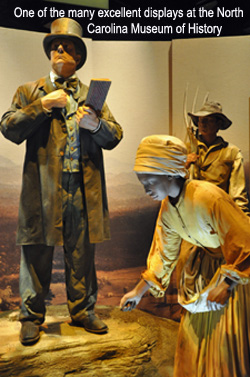 North Carolina has ten National Parks. The Blue Ridge Parkway is one of these sites. While most people see the Parkway as a road for a drive or a place to hike, there are plenty of opportunities for hands-on history as well. There are five campgrounds along the North Carolina section of the Parkway. Each has an amphitheater, and in the late spring, summer and early fall, programs for the public take place on Friday and Saturday evenings. These programs, always free, cover a range of topics, from local history to plants and animals. As an added bonus, there are annual events, such as the Civil War Living History at Linville Falls in June and the Overmountain Men living history at the Mineral Museum in September. In the east is Moore’s Creek National Battlefield, commemorating an early Patriot victory in the American Revolution. There are special tours and demonstrations throughout the year. To the north of Moore’s Creek is the Wright Brothers National Memorial. This site has a small entrance fee. There are artifacts in the museum, reproduction hangers and a commemorative flight line.
North Carolina has ten National Parks. The Blue Ridge Parkway is one of these sites. While most people see the Parkway as a road for a drive or a place to hike, there are plenty of opportunities for hands-on history as well. There are five campgrounds along the North Carolina section of the Parkway. Each has an amphitheater, and in the late spring, summer and early fall, programs for the public take place on Friday and Saturday evenings. These programs, always free, cover a range of topics, from local history to plants and animals. As an added bonus, there are annual events, such as the Civil War Living History at Linville Falls in June and the Overmountain Men living history at the Mineral Museum in September. In the east is Moore’s Creek National Battlefield, commemorating an early Patriot victory in the American Revolution. There are special tours and demonstrations throughout the year. To the north of Moore’s Creek is the Wright Brothers National Memorial. This site has a small entrance fee. There are artifacts in the museum, reproduction hangers and a commemorative flight line.
 North Carolina has twenty-seven historic sites and forty-one state parks, spread from Roanoke Island to Asheville. A place to start, and one place every person should visit, is the excellent North Carolina Museum of History in Raleigh. The centerpiece is the 20,000 sq. ft. exhibit entitled “The Story of North Carolina.” From Native American history through the Civil Rights movement, the story of our great state is presented. There are permanent and rotating exhibits, from the North Carolina Sports Hall of Fame to an exhibit on North Carolina’s military heritage. Across the street from the Museum of History sits the 1840 state capitol. Visitors can tour the building, from the old General Assembly chambers to the state library and state geologist’s office. The capitol still houses the offices of the governor and lieutenant governor, and if neither is in, visitors can get a peek inside the offices where they work. Both the museum and the capitol are free. From time to time, the Museum of History brings in special exhibits that do carry a small admission charge.
North Carolina has twenty-seven historic sites and forty-one state parks, spread from Roanoke Island to Asheville. A place to start, and one place every person should visit, is the excellent North Carolina Museum of History in Raleigh. The centerpiece is the 20,000 sq. ft. exhibit entitled “The Story of North Carolina.” From Native American history through the Civil Rights movement, the story of our great state is presented. There are permanent and rotating exhibits, from the North Carolina Sports Hall of Fame to an exhibit on North Carolina’s military heritage. Across the street from the Museum of History sits the 1840 state capitol. Visitors can tour the building, from the old General Assembly chambers to the state library and state geologist’s office. The capitol still houses the offices of the governor and lieutenant governor, and if neither is in, visitors can get a peek inside the offices where they work. Both the museum and the capitol are free. From time to time, the Museum of History brings in special exhibits that do carry a small admission charge.
 The state has a wealth of other resources as well, from Town Creek Indian Mound in Montgomery County, the Alamance Battlefield in Burlington, the transportation museum at Spencer, Civil War sites such as the Zebulon Baird Vance Birthplace near Weaverville, the Bentonville Battlefield near Smithville and literary sites, including the Thomas Wolfe House in Asheville. State parks that have good history-related museums include Mt. Mitchell, the USS North Carolina, and Forts
The state has a wealth of other resources as well, from Town Creek Indian Mound in Montgomery County, the Alamance Battlefield in Burlington, the transportation museum at Spencer, Civil War sites such as the Zebulon Baird Vance Birthplace near Weaverville, the Bentonville Battlefield near Smithville and literary sites, including the Thomas Wolfe House in Asheville. State parks that have good history-related museums include Mt. Mitchell, the USS North Carolina, and Forts  Fisher and Macon. Some of these sites charge admission and some do not. It is best to check before you go, as many sites offer discounts and special programs for homeschoolers that you can receive only if you make arrangements in advance.
Fisher and Macon. Some of these sites charge admission and some do not. It is best to check before you go, as many sites offer discounts and special programs for homeschoolers that you can receive only if you make arrangements in advance.
Across North Carolina are several regional museums that are of high quality. These include the Museum of the Cherokee Indian in Cherokee, the Greensboro Historical Museum in Greensboro, and the Museum of the Cape Fear Historical Complex in Fayetteville. These museums all charge admission, but the quality of their fantastic exhibits is well worth the price. Sometimes, you can purchase a package ticket for several sites, such as in Cherokee, and receive a discount, but it is also a good idea to contact the site ahead of time for special homeschool opportunities.
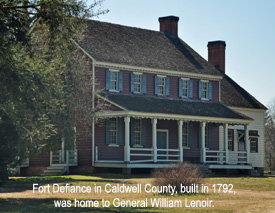 Last, but certainly not least, are a century’s worth of local history museums. Almost every county has one or two or more. They contain stories of the past of that particular area. The artifacts are as varied as the counties themselves, and often they are housed in significant historical buildings. Once again, some have free admission and others charge a small fee.
Last, but certainly not least, are a century’s worth of local history museums. Almost every county has one or two or more. They contain stories of the past of that particular area. The artifacts are as varied as the counties themselves, and often they are housed in significant historical buildings. Once again, some have free admission and others charge a small fee.
The programs and services offered by these museums are as varied as the sites themselves. The Museum of History in Raleigh has events for all age groups, including an American Indian Heritage Education Day in November and an African-American Cultural Celebration in January. Other events are often going on, such as costumed historic interpreters just hanging out in the lobby, ready to talk with visitors and answer questions. For the past year, an exhibit on Blackbeard’s Queen Anne’s Revenge has been touring the state. The North Carolina Maritime Museum in Beaufort offers programs on whales, lightships and light towers and even boatbuilding.
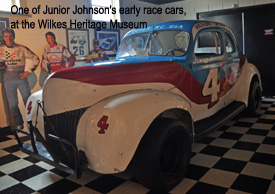 Many of the museums across the state have homeschool days, encouraging homeschoolers to get out and explore these sites. Often there are interpreters demonstrating some skill of old. At times, young people are encouraged to join in, working in a garden, weaving or making a craft. Having these experiences are great for people of all ages. History is more than just words on a page and by visiting these sites, people can see the past, touch it, smell it and even taste it. Since homeschoolers are known for a love of experiential education, the volunteers and staff of historic sites often look forward to having homeschoolers visit and will cater to the particular students’ interests.
Many of the museums across the state have homeschool days, encouraging homeschoolers to get out and explore these sites. Often there are interpreters demonstrating some skill of old. At times, young people are encouraged to join in, working in a garden, weaving or making a craft. Having these experiences are great for people of all ages. History is more than just words on a page and by visiting these sites, people can see the past, touch it, smell it and even taste it. Since homeschoolers are known for a love of experiential education, the volunteers and staff of historic sites often look forward to having homeschoolers visit and will cater to the particular students’ interests.
For people who want to get even more out of the great historic resources in the state, every one of the hundreds of sites in our great state are looking for volunteers. This is a way to make sure that your children not only have a hands-on experience, but is also a way to give back to the community at large. After all, as homeschoolers know, knowledge is a gift to be shared, and our state historic sites can allow homeschooled students to both earn and to share their knowledge. Our historic sites may be the most interesting classrooms any student can visit.

